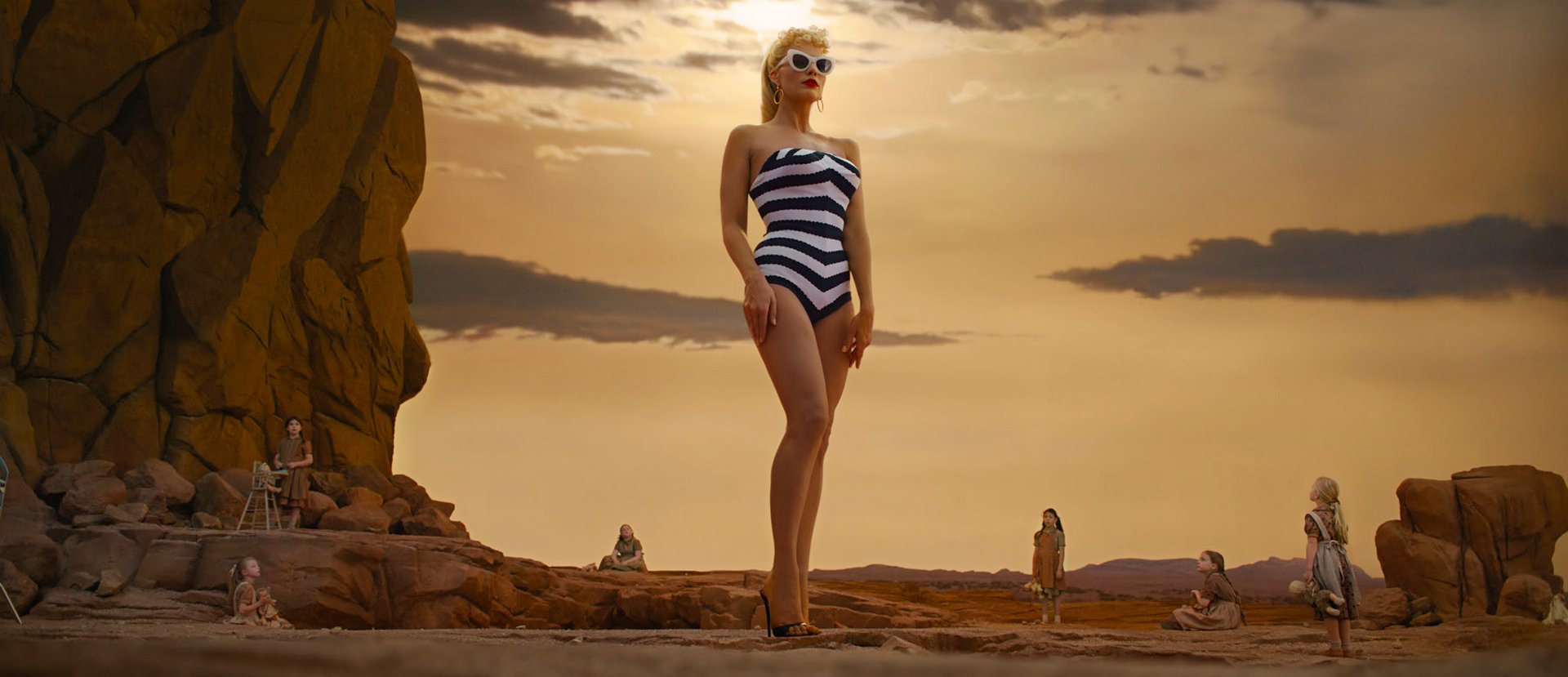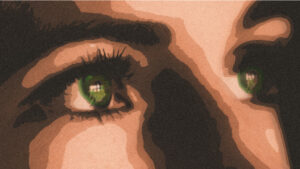
Reviewed by: Jim O'Neill CONTRIBUTOR

Story based on the Mattel toy doll
Woke messaging in films
A feminist critique of capitalism
Barbie having an existential crisis
Films that appear to be for youngsters, but are NOT
Transgenderism promotion by Hollywood
Hollywood leftist deconstruction of ‘gender roles’ and increasing man bashing in movies
Feminism’s sexist anti-man messaging—painting masculinity as toxic and predatory / males as idiots, bigots or pathetic losers
Is the FEMINIST MOVEMENT the right answer to the mistreatment that some women endure in this sinful world? Answer
Social satire
Films that attempt to contrast fantasy and dark reality

G reta Gerwig’s “Barbie” has a cotton candy wispiness that would be fine for a movie about a doll that comes to life, but behind the pink frosting facade, Gerwig has spun candy that is hard—and sour.
Gerwig, and her partner, Noah Baumbach , who co-wrote the script, might appear to be apt choices to make a film about the odd person out trying to catch a break on the inside while still maintaining the quirkiness of an appealing outsider. Gerwig’s performances as an actress in Whit Stillman’s “Damsels in Distress” and Baumbach’s “Frances Ha” were iconoclastic and daringly funny. Her insouciant embodiments of “innocent as doves” but secretly “wise as serpents” space-cadets in the mold of Zasu Pitts, Billie Burke and Judy Holliday, were a breath of fresh air.
As a director, however, Gerwig’s focus and tone have become stale, dour and accusatory. The wrathful “ Lady Bird ” and the unfaithful (literally and scripturally) “ Little Women ” were both successes, taking her from “low-budget indie” wannabe to well-healed Hollywood A-lister. As such, she not only abides by the rules of the realm, but has become one of its most reliable and outspoken voices.
With “Barbie,” Gerwig does everything bigger, bolder and louder. There is no soft underbelly to this doll. The film is pepper-sprayed with bursts such as: “either you’re brainwashed or you’re weird and ugly; there’s no in-between,” and my favorite, spoken to Barbie by a teenage student (a re-run of the “Lady Bird” speech shouted by that film’s title character to a conservative religious woman, a favorite Gerwig target): “You represent everything wrong with our culture… you destroyed the planet… you set feminism back,” and so on, concluding her “j’accuse” diatribe by calling Barbie “a fascist.” That kind of red-faced hectoring never lets up. Too often I felt as though I was sitting through a “Libs of TikTok” marathon .
The movie’s plot is a terse throw-away. The main doll, “Stereotypical Barbie” ( Margot Robbie ) lives in a fantasy world called Barbieland with all kinds of other Barbies who live in dream houses and drive dream cars. It is a feminist , but peculiarly unfeminine, environment in which the president is a woman, all nine Supreme Court justices are women, health care is provided by women, and businesses are run by women. The men, labeled “superfluous” citizens, are not even relegated to the sidelines; they have no place on the field at all.
A crack develops in Barbieland allowing Barbie to travel from fantasy land to the real world, a contrived plot device and a cheap “Matrix” rip-off, the first of many such “borrowings” from or references to earlier classic films, ironically ones made by decidedly non-feminist, macho filmmakers such as Stanley Kubrick, Francis Ford Coppola and, astonishingly, Robert Evans.
Each Barbie in Barbieland may have a plastic doll counterpart in the real world. Evidently, whatever happens to the doll and her owner in that realm has a concomitant effect on the Barbieland inhabitant. When the main Barbie starts developing human maladies such as flat feet and a bit of cellulite, she does not consult a Barbieland podiatrist or luposucionist (both of whom one would suspect in a perfect Barbie world would be crackerjack practitioners of their specialties), but instead travels to the real world (yes, in a pink Cadillac, pink motorboat, and pinkish rocket ship) to find the little girl whose dark thoughts has brought on her distress. Little does she know that her existential trip, for a doll, will lead her to fall into the clutches of the dark and male infested hands of the toy company that makes her, Mattel.
The Mattel conglomerate is located in Los Angeles, and traveling from one LaLa land to another could be fodder for some good jokes about how real and imaginary places may not be so different (remember the Star Trek movie scenario of the Enterprise landing in San Francisco, a place weirder than any extraterrestrial sphere could be?), but that nerve is never touched. Gerwig and Baumbach do know what side their bread is buttered on. There’s nothing new brought to this battlefield, even with Will Ferrell playing Will Ferrell playing a Ken-like dodo playing a past-his-prime jerk.
With each new performance, Ferrell is morphing into an A.I. version of himself, but in this case he sputters lines that an A.I. program, or even a Barbieland doll, would roll their eyes at.
In the real world, Stereotypical Barbie is absconded by secret service like Mattel minions while a befuddled Ken debates whether to rescue her or seek help. You may have already guessed that the film does not miss the opportunity to further emasculate Ken as he chooses to run back to Barbieland for help. Adding further insult to injury, he never returns for her either.
Meanwhile, Ferrell and his boardroom cohorts, all men in dark suits, prove to be easy, cookie-cutter targets. The strongest corporate retort to Barbie’s criticisms of their non-inclusiveness and all around non-niceness is a timid: “Some of my best friends are Jewish.”
This from Hollywood’s A-list original screenplay team?
Gerwig’s Barbie does not grow into a flesh and blood girl in the same way Pinocchio evolved into a boy through humility and self-sacrifice. She is inordinately cruel to Ken and seems to have a cold core, one that Margot Robbie sometimes brings to the surface, channeling the murderous character she played in the “ Suicide Squad ” movies, and giving her doll an edge that is sharp, if at times a bit rusty. Robbie has an inviting and generous smile which Quentin Tarantino used to enchanting effect in “ Once Upon a Time in Hollywood ,” but she can turn that smile to something sinister and deadly, as she did in the underrated “ Mary, Queen of Scots ,” in which she used her grin as a mask to soften, or conceal, the human monster, and political genius, that was Queen Elizabeth I. In “Barbie,” Robbie can’t seem to get the balance right. She holds onto the Mattel plastic while keeping the vulnerable humanity at bay.
The film begins with Barbie, standing as a tall bathing-suit clad monolith surrounded by a bevy of very young girls who defiantly smash and toss away their baby dolls. It’s not just a cheesy rendition of Kubrick’s “2001: A Space Odyssey” opening where the apes bang bones they learned to use as weapons, but a cold and cynical cry for emancipation from the binds of what motherhood, and traditional womanhood, represent to the modern Hollywood sensibility.
As the movie unfolds, its makers herald the positives of such liberation, but shy away from its downsides. Barbie nonetheless develops a crisis of confidence, and then one of existence itself. Her anxiety is deep, the result we’re told, of patriarchal oppression, leading Barbie to have “irrepressible thoughts of death.”
When a tale starts, not with life as the Genesis story does, but with death, and that is what the baby destroying scene represents, it is fated to come full circle. Barbie’s “irrepressible thoughts” are about more than chauvinism. Those thoughts cry out for redemption and rebirth.
Despite her eschatological concerns, this living doll has no spiritual dismay and no sense of what she was created for. Does she look to Someone who, before she was formed, knew her? Her self-reliance, cynically referred to as empowerment, blinds her to seeing that “all things in heaven and earth, the visible and the invisible…were created through Him and for Him.” Barbie jumps from battle to battle, emulating the Director’s own personal fight for the rights of marginalized women everywhere, but by never putting on “the shield of Christ ,” she is ultimately unequipped to “fight the good fight.” No wonder she and her real world counterpart have thoughts of despair and death.
Did I mention those thoughts are applauded by film’s end?
You know a movie’s script and production are weak when so much depends on a bevy of supporting and cameo appearances by underused, underwritten, or just miscast performers such as America Ferrera , Michael Cera , Issa Rae , Rhea Perlman , and John Cena who seem mostly befuddled by the polemic drivel they have to speak.
Helen Mirren is inexplicably and shamefully used as a narrator trying to elucidate the film’s mangled background story. Her commentary only makes this hapless doll world murkier and more punishing, declaring that playing with dolls might be fun, but ultimately harms little girls everywhere. Her voice, meant to be authoritative and instructive, is actually authoritarian and beguiling, like that of a matronly garden serpent.
Almost all the performances are amateurish and attention-seeking in the worst way, none more so than Kate McKinnon’s whose lack of comic skill is hidden behind by a tremendous well of self-regard. She plays “Weird Barbie”, not in a knowing and endearing sidekick-style in the vein of Eve Arden or Joan Cusack , but in a shrill and geyser-like fashion that is as jarring as her costume and inconsistent make-up.
There are several Kens, each different looking, but each behaving in basically the same way. Ryan Gosling plays the main Ken, and he almost brings it off. While watching him in all his tanned and bleached splendor, I wondered if his entire performance was nothing more than attempt to humor his director and co-star. He constantly tosses off his ridiculous costumes in the same style he throws away the beach taunts aimed at his co-Kens. Those exchanges, meant to be in-the-know jokes that would go over the heads of kids but tickle the ear of hip adults, are witless and sophomoric in their barely disguised homoeroticism .
Ken tags along uninvited on Barbie’s trip to the real world. She drives, of course, while he straddles the back seat. Unlike Barbie, Ken is captivated by the male energy of Los Angeles. He tries to bring that equine force back to Barbieland and build a society where men sport great biceps and abs, and have a great time drinking beer and dominating their female counterparts. There’s lots of male bonding in the new realm called Kendom, with men co-decorating their houses in horse motifs, exchanging outfits that include fancy furs, and doing bump, grind and male on male cheek-to-cheek kiss ala Busby Berkeley style dance routines on the beach and somewhere in the sky. This is presented as a patriarchy on steroids, a male world out of control.
Gosling’s god-like surface features seem particularly anti-feminist, the kind of physical specimen that you would not expect to find in a land ruled by powerful women, but the type you’d see on the covers of bodice-ripper novels or People’s Sexiest Man Alive issues, or perhaps in a Village People music video. But consistency is not a hallmark in the Gerwig-Baumbach universe. Discordancy is the point. The film’s liberation ethos, sexual and social, is a call, not for peace, forgiveness, and grace , or even enjoyment of what a world of toys can bring to a child, but a Progressive call to arms.
Or worse, it’s a gender studies lecture, where many Barbies and Kens are welcome, but only one voice, a very Feminist voice is allowed to speak, and be heard.
- Wokeism: Very Heavy
- Drugs/Alcohol: Moderate
- Violence: Mild
- Profane language: Minor
- Vulgar/Crude language: Minor
- Nudity: None
- Occult: None

Editor’s Notes
For the narrative arc, Writer/Director Gertwig was partially inspired by the 1994 non-fiction book Reviving Ophelia by Mary Pipher, which accounts the effects of societal pressures on American adolescent girls. The book has been described as a “call to arms” and highlights the increased levels of sexism and violence that affect young females. Pipher asserts that whilst the Feminist movement has aided adult women to become empowered, teenagers have been neglected and require intensive support due to their undeveloped maturity. Lead actress Margot Robbie stated that the film’s aim is to subvert expectations and give audiences “the thing you didn’t know you wanted.”
NOTE: In June 2023, a “Barbie” French poster went viral for including the tagline “Elle peut tout faire. Lui, c'est juste Ken.”, which literally translates to “She can do everything. He’s just Ken.” However, ken is the verlan slang term for the f-word in French, while c’est (“he is”) is a homophone for sait (“he knows how”), meaning the tagline could be read as “She can do everything. He just knows how to f***.” Analysts concluded that it was likely the pun was intentional, as the slang term is common knowledge among French speakers, though Warner Bros. would neither confirm nor deny whether this was the case.
See list of Relevant Issues—questions-and-answers .
- Non-viewer comments
PLEASE share your observations and insights to be posted here.
- Featured Essay The Love of God An essay by Sam Storms Read Now
- Faithfulness of God
- Saving Grace
- Adoption by God
Most Popular
- Gender Identity
- Trusting God
- The Holiness of God
- See All Essays

- Best Commentaries
- Featured Essay Resurrection of Jesus An essay by Benjamin Shaw Read Now
- Death of Christ
- Resurrection of Jesus
- Church and State
- Sovereignty of God
- Faith and Works
- The Carson Center
- The Keller Center
- New City Catechism
- Publications
- Read the Bible
- TGC Pastors

U.S. Edition
- Arts & Culture
- Bible & Theology
- Christian Living
- Current Events
- Faith & Work
- Gospelbound
- TGC Podcast
- The Carson Center Podcast
- The Everyday Pastor
- You're Not Crazy
- As In Heaven
- Churches Planting Churches
- Help Me Teach The Bible
- Post-Christianity?
- Word Of The Week
- Past Conference Media
- Foundation Documents
- Advertise With Us
- Regional Chapters
- Church Directory
- Global Resourcing
- Donate to TGC
To All The World
The world is a confusing place right now. We believe that faithful proclamation of the gospel is what our hostile and disoriented world needs. Do you believe that too? Help TGC bring biblical wisdom to the confusing issues across the world by making a gift to our international work.
Christians Should Welcome the Conversations ‘Barbie’ Sparks
More by jen oshman.

I grew up playing with Barbie. Like many women reading this, I had scores of them, as well as the Barbie Dreamhouse, the convertible, the swimming pool, and one Ken doll (Mattel sells seven Barbies for every one Ken). Generations of us gathered in each other’s bedrooms to create stories for our Barbies and act them out. We changed their clothes a lot and made-believe the good life for our plastic collections. Through them, we imagined our own futures. Barbie served the aspirational purpose that her creator, Ruth Handler, envisioned for girls.
But as we came of age, our relationship with Barbie grew increasingly distant and even cold. At first, it was just that we outgrew pretend doll play. But then we became preteens and teens and—parallel to what the Barbies in Greta Gerwig’s Barbie movie experience—we emerged from our playtime paradise where everything was made according to our own ideals and dreams. We had to face the real world.
We gained unpleasant knowledge. Our eyes were opened. Barbie’s aspirational qualities were countered by something sinister. As the moody teen Sasha (Ariana Greenblatt) says to Barbie (Margot Robbie) when she first meets her, “You’ve been making women feel bad about themselves since you were invented. . . . You destroy girls’ innate sense of worth.”
Sizing Up Barbie
Are Barbie dolls good or bad? This is one of many philosophical questions the new film asks. And while you may assume audiences don’t want to think about weighty questions in a Barbie movie, consider that Barbie had the highest-earning opening weekend for all films so far in 2023, as well as the highest-earning one ever for a female-directed film. Greta Gerwig ( Lady Bird and Little Women ) has clearly struck a chord, fueling immense social media chatter and launching countless hot takes.
In the movie, newfound knowledge requires Barbie to leave Barbieland for the Real World. Ken (Ryan Gosling) joins her but returns early to establish the Kendom while she’s still away. The result is a power struggle between the two genders as all the Barbies and Kens try to determine their purpose and place in the world. The film may have a minor plot, but it asks major questions. Barbie is creating plenty of community and controversy, both online and in real life. It’s forcing a conversation that’s relevant for the church—but I’m not sure we’re ready to have it.
It’s Complicated
The answer to the question of whether Barbie dolls are good or bad is this: it’s complicated. The same is true of the movie and all the themes it brings to the surface. Gerwig is unwilling to present obvious conclusions throughout, highlighting the complex ways men and women relate to themselves and to one another in this cultural moment.
Gerwig’s refusal to be simply “pro” or “con” is the film’s greatest strength (other than, admittedly, Ryan Gosling’s over-the-top hilarious performance as Beach Ken). Consider just a few of the major topics Gerwig’s film explores.
Barbie is forcing a conversation that’s relevant for the church.
Barbie, herself an icon for feminism, was created in the 1950s so little girls might imagine their own grown-up lives when they play with Author Barbie, Doctor Barbie, Physicist Barbie, and more. The movie, though, causes the audience to ask, “Is feminism good or bad?” It doesn’t offer a neat and tidy answer. The film seems to say that if feminism helps little girls grow up to be all they can be and fulfill a diversity of roles, it’s good. But if feminism says men aren’t needed, it’s bad. As with all tough topics in the movie, it’s multilayered.
Some viewers have claimed the film is antimotherhood. There may be some truth in that claim. Pregnant Barbie is sidelined and called weird. The opening scene doesn’t want little girls to envision themselves as only the mothers of babies.
On the other hand, the human mother-daughter relationship (America Ferrera and Ariana Greenblatt) develops sweetly. Most mothers and daughters can see themselves, at least a little bit, in their dynamic. And the way they come together to cheer for one another and all women is good . There’s a photo montage near the end of the film that brings many viewers to tears. It conveys the message “Growing up as a girl is hard, but it’s very good.” Many walk away from the movie appreciating motherhood even more. Barbie’s maker says to her, “We mothers stand still so that our daughters can look back and see how far they’ve come.”
One of the most polarizing aspects of Barbie is its portrayal of men. It’s true, there are no genuinely good or smart male characters present (except maybe Allan). As with the toys, Ken is an accessory to Barbie. The Kens in the movie portray what it’s like to be identifiable only by one’s connection to another person.
But to say the film is bad because it makes men look bad is to miss the point of Ken and his Kendom altogether. Gerwig wants us to consider what it’s like to live in another’s shadow, something many women regularly feel—even in 2023. It would be simplistic to say the Barbie movie disses the patriarchy and exalts the matriarchy. It’s clear in the movie that neither is good for anyone.
There are a dozen more themes worthy of dissection, and absolute proclamations about any of them short-circuit the film’s invitation to reflect on these issues from multiple angles. Prematurely proclaiming “It’s good!” or “It’s bad!” shuts down important conversations about identity and gender and how men and women can live in harmony and even advocate for each other. These conversations are certainly needed in culture. As Christians, we should admit they’re also needed in the church.
Why ‘Barbie’ Matters for the Church
Of the 40 million people who’ve stopped going to church over the last 25 years, 10 percent say they left specifically because of misogyny . More than one leading Christian denomination in the U.S. is currently embroiled in a scandal of widespread sexism and sexual abuse. Anecdotally, women in ministry across the nation will tell you they struggle to know how to function in the church because they’ve been discipled (inadvertently or not) to see themselves as threats, temptresses, or less than their male counterparts. We feel at once too much and not enough. (It may be therapeutic for one of us to write and share a replica of America Ferrera’s fiery monologue but for women in ministry.)
The Barbie movie invites a conversation about our identities both as individuals and as men and women together. We Christians have the tools to engage this conversation, both inside the church and out there in the world, but will we? Are we willing to think deeply, listen patiently, and share honestly?
There’s a significant thread throughout the Barbie movie that ponders creation and Creator, the relationship between Adam and Eve, and the question of all questions: What are we made for? Spiritual and anthropological questions abound in the film, but answers are hard to come by.
Perhaps it’s a testament to our “all over the place” cultural confusion on these topics that Barbie has sparked such a multitude of (sometimes contradictory) interpretations. In a culture grappling for solid handles to approach the slippery questions of identity, it’s no wonder the meaning of Barbie —like the toys we used to play make-believe with—is essentially whatever the viewer wants it to be. Without God and Scripture guiding the way, questions of human identity (including gender) and purpose default to subjectivity.
But whereas the movie falls short in giving clear answers to massive questions about life and gender, Christians should not. We know the God who made us and died to save us. We know what humans are made for. We know both men and women are very good and both men and women need each other. We have God’s Spirit and God’s Word to enable us to be on mission together.
Whereas the movie falls short in answering massive questions about life and gender, we should not.
Rather than slipping into the sex segregation and suspicion that comes so easily in the flesh, let’s stand side by side, eager to honor and advocate for one another. Let’s resist church versions of Barbieland and Kendom, where men and women are pitted against each other. Let’s resist too-fast and too-easy answers to complicated questions. Let’s listen to one another. Let’s behave as the siblings we’re meant to be.
Try Before You Buy: FREE Sample of TGC’s New Advent Devotional

Unto Us is designed to help you ponder the many meanings of this season. Written by TGC staff, it offers daily Scripture readings, reflections, and questions to ponder. We’ll send you a free sample of the first five days so you can try it out before purchasing it for yourself or your church.
Jen Oshman has been in women’s ministry for over two decades on three continents. She’s the author of Enough About Me , Cultural Counterfeits , and Welcome . She hosts a weekly podcast about cultural events and trends called All Things , and she’s the mother of four daughters. The family currently resides in Colorado and they planted Redemption Parker , where Jen is the director of women’s ministry.
Now Trending
1 what justin welby’s resignation can teach evangelicals, 2 should christians reject slavery and affirm same-sex marriage, 3 how the pro-life movement lost and won in the election, 4 how an australian church is changing christian songwriting, 5 we won’t do nothing for eternity.

Why We Won’t Spend Eternity in Heaven
God created the world to function as his sanctuary—for heaven and earth to be one location—but this intention never came to pass. It will one day.
Why Women Use Pornography and How the Church Can Help

Why Young Women Are Leaving the Church and How Pastors Can Help

New Getty Song Rivals ‘In Christ Alone’

What Does the Bible Teach About Divorce and Remarriage?


Not the Halloween You Remember

The Five Solas

Latest Episodes
Preaching christ in every sermon.

Biblical Faith Seeks Scientific Understanding

Dry Seasons, Imposter Syndrome, and Reawakening: Season 4 Q&A with Sam and Ray

When the Lord Brings Judgment (Ezek. 4–5)

How an Australian Church Is Changing Christian Songwriting

I Am the Resurrection and the Life (John 11:17–44)

Trevin Wax on Reconstructing Faith

Examining the Current and Future State of the Global Church

Welcome and Witness: How to Reach Out in a Secular Age

Faith & Work: How Do I Glorify God Even When My Work Seems Meaningless?

Let’s Talk Reunion: The Blessings of Bible Study with Friends

Getting Rid of Your Fear of the Book of Revelation

Looking for Love in All the Wrong Places: A Sermon from Julius Kim

Introducing The Acts 29 Podcast

IMAGES
VIDEO